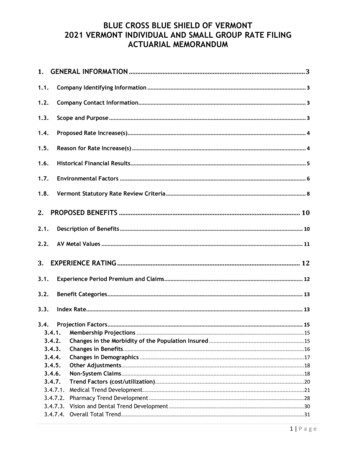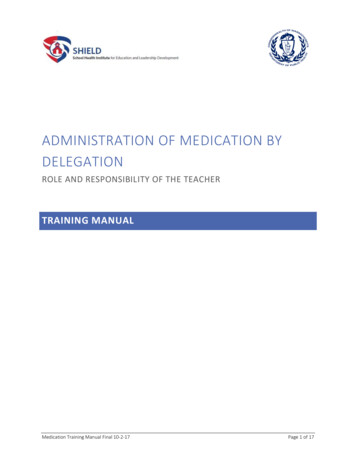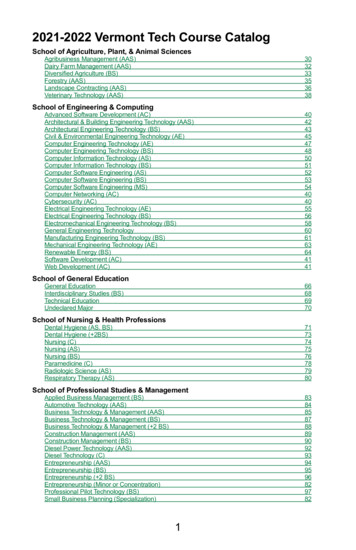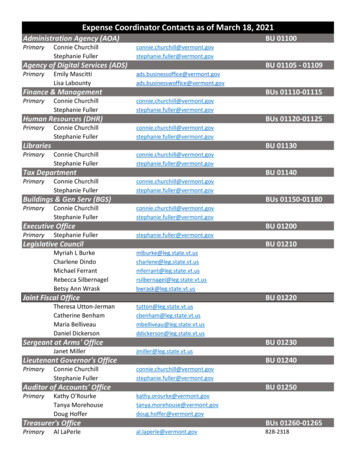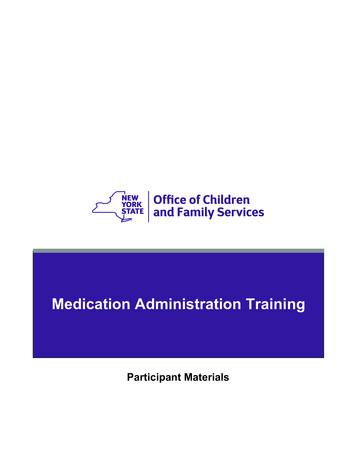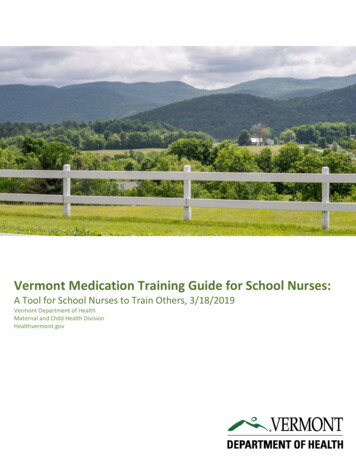
Transcription
Vermont Medication Training Guide for School Nurses:A Tool for School Nurses to Train Others, 3/18/2019Vermont Department of HealthMaternal and Child Health DivisionHealthvermont.gov
Section 1 – Introduction5Purpose5Medication Administration Responsibilities5Acknowledgements5Gratitude for Reviewers5Disclaimers6Clarifications6Healthcare providers defined – National Council of State Boards of Nursing (NCSBN) (SeeResources and References)6Section 2 - Vermont Medication Laws8Section 3 - School Nurse (SN)/Associate School Nurse (ASN) Delegation in School Settings9Principles of Delegation9Delegation Process9Documenting Delegation9Rescinding Delegation10Transferring Delegation10Summer School11School Nurse/Associate School Nurse Delegation Considerations12Section 4 - Training of Unlicensed Assistive Personnel in the Administration of Medication12Part 1: General guidance for any delegation related to medication by a SN/ASN12Part 2: Guidance for delegation of individual medications to a UAP12Part 3: Guidance for delegation to a UAP who is to administer medications to all students asdesignated by the SN/ASN.13Part 4: Guidance for training PreK personnel or those who might work in childcare settings13Section 5 - General Medication Guidance and Routes of Administration (See Federal DrugAdministration Table of Routes of Administration (with accepted abbreviations) (See Resourcesand Reference)132/50
Oral Medication, By Mouth, By Gastrostomy (Enteral)13Inhaled Medication, Nasal, By Mouth14Topical Medications: Lotions/Sunscreen, Ointment, Patch, Cream, Paste14Eye Drops14Ear Drops14Injection Medications14Rectal Medications14Section 6 – Nursing Practice and Board of Pharmacy Recommendations, Licensed HealthcareProviders Who May Prescribe and Administer Medications15Out of State Prescriptions15Receipt of Medication15Inventory of Medication and Monitoring of Expiration Dates16Storage and Security of Medication16Student Not Reporting for Medication17Student Refusal of Medication18Early Dismissal and Student Medication18Changes in Student’s Medication Order18Documentation18Record Retention Requirements19Confidentiality and Privacy20Discontinuing Medication21Disposal of Medication21Medication Error21Section 7 – Student Self-Administration of Medication23Section 8 – Anaphylaxis and Asthma Medication23Section 9 – Diabetes Medication243/50
Section 10 – Seizure Medication24Section 11 – Additional Guidelines25Complementary and Alternative Medicine (CAM) Products, and Over the Counter (OTC)Medications25Oxygen (O2) is a prescription medication requiring an order from a licensed medicalprofessional26Medical Marijuana (Cannabis)26Medication for exchange students27Medication Orders for Students of Military Families27Medication Orders for Homeless Students27Section 12 – Field Trips, School Sponsored Events and Summer SchoolOut of state and out-of-country trips should follow LEAs and Schools policies andprocedures and allow 2-8 weeks notification and preparations with the SN/ASN2829Section 13 – Disaster Planning/Medication29Section 14 – Frequently Asked Questions30Section 15 – Resources and References34oEndorsement Rule 5440 VSBPE Licensing Endorsements,35 Associate School Nurse Endorsement, 65-A, pg. 13835Section 16 – Appendices (SAMPLE Protocols, Procedures, and Forms) [under construction]37Medication Delegation Handout [c/o Deb Hanson, Fair Haven School, Nov. 2018]40SAMPLE Training Activity44SAMPLE SCHOOL HEALTH ASSISTANT JOB DESCRIPTION504/50
Section 1 – IntroductionPurposeThese guidelines provide recommendations for the safe administration of medication inVermont schools and school sponsored activities. They are designed to guide school nurses inthe training of unlicensed assistive personnel (UAP), and others as designated by that schoolnurse. Medications are to be administered to students in compliance with state and federalstatutes. This document provides general recommendations for medication management inschools, as well as links to helpful resources and sample forms and tools.Medication Administration ResponsibilitiesIt is the school’s responsibility to ensure that medications are administered as authorized by theparent/guardian and licensed healthcare provider (LHP), and as outlined in any relevantindividual healthcare plans (IHP). As a bridge between healthcare and the school communities,the school nurse/associate school nurse (SN/ASN) role of care coordination involves buildingstrong working relationships with families and their medical communities. This foundation oftrust allows communications to flow smoothly and for family and student-centeredaccommodations for chronic health conditions to be implemented, supporting studentwellbeing and successes.AcknowledgementsSchool Nurse Advisory Committee 2017/18 - 2019:Sophia Hall, President of Vermont State School Nurses’ Association, Millers Run Union School,Caledonia North Supervisory UnionLouisa Driscoll, School Nurse, St. Johnsbury School DistrictMartha Israel, School Nurse, Washington Central Supervisory UnionAmy Ridlon, School Nurse, Barstow Memorial SchoolDeborah Hanson, School Nurse, Fair Haven Union High SchoolJenny Anderson, Springfield High School, SpringfieldThomas Aloisi, Health Educator, Agency of EducationNathaniel Waite, PHN, Program Coordinator, VT Department of HealthBreena Holmes, MD, Division Director, Maternal and Child Health, VDHSharonlee Trefry, State School Nurse Consultant, ChairJanuary 2019Gratitude for ReviewersVermont School Board’s Insurance Trust (VSBIT)Vermont Board of Nursing Executive Director5/50
Vermont Department of Health Legal DepartmentVermont Agency of Education Legal DepartmentVermont Board of Pharmacy, Executive DirectorDisclaimers Recommendations made in these guidelines should never be substituted for legalcounsel in a particular situation.Sometimes the law is silent or may be unclear; in these instances, it is recommendedthat district administrators consult with district legal counsel and/or a risk managementconsultant and to follow best healthcare practices.When addressing situations or questions, consider district policies and procedures thatshould reflect current state and federal statutes as well as district practice.The provision of forms and documents in the appendices are samples only and are notendorsed by Vermont Agency of Education (AOE), Department of Health (VDH) or anyLocal Education Agency (LEA).Any sample contained in these guidelines that may be utilized and adapted should beapproved by each individual LEA or school ’s administration and/or board of directors asapplicable.Clarifications The terms physician, medical doctor, nurse practitioner, physician’s assistant, primarycare provider, licensed healthcare professional, licensed healthcare provider, and healthcare practitioner will be referred to as a licensed healthcare providers (LHP) orprofessionals with prescriptive authority."License": holds a current Vermont license in a specific medical or healthcare specialty(3 V.S.A. §§ 121-132)Unlicensed Assistive Personnel (UAP): describes any unlicensed person, regardless oftitle, who performs tasks delegated by a nurse. (See Resources and References)School Sponsored Activities: Section 12 - Field Trips, School Sponsored Events, andSummer SchoolHealthcare providers defined – National Council of State Boards of Nursing (NCSBN) (SeeResources and References) Advanced Practice Registered Nurse (APRN): An RN who has a graduate degree andadvanced knowledge. There are four categories of APRNs: certified nurse-midwife(CNM), clinical nurse specialist (CNS), certified nurse practitioner (CNP) or certifiedregistered nurse anesthetist (CRNA). These nurses can diagnose illnesses and prescribetreatments and medications. (NCSBN) Associate School Nurse (ASN): Holds an AOE 65-A (Endorsement Rule 5440 VSBPELicensing Endorsements, pg. 1386/50
Certified Medication Aide/Assistant (MA-C): An individual who is certified to administermedication under the supervision of a nurse. (NCSBN) Certified Nursing Aides/Assistant (CNA): An individual who is certified to assist with thedelivery of direct nursing care to patients. Works under the supervision of a nurse.(NCSBN) Registered Nurse (RN): An individual who has graduated from a state-approved schoolof nursing, passed the NCLEX-RN Examination and is licensed by a state board of nursingto provide patient care. (NCSBN) Licensed Nursing Assistant (LNA): (2) "Nursing assistant" means an individual whoperforms nursing or nursing-related functions under the supervision of a licensed nurse.(26 V.S.A. § 1641 (2).) Licensed Practical/Vocational Nurse (LPN/VN): An individual who has completed a stateapproved practical or vocational nursing program, passed the NCLEX-PN Examination,and is licensed by a state board of nursing to provide patient care. Normally worksunder the supervision of a registered nurse, advanced practice registered nurse orphysician. (NBCSN) Licensed School Nurse (SN or LSN) 5440-65 School Nurse: The holder is authorized toprovide school health services in grades PK-12 and to collaborate with teachers andadministrators to integrate health and wellness knowledge and skills throughout theschool and curriculum based on knowledge of pediatric, community health, emergency,adult, and mental health nursing. (Endorsement Rule 5440 VSBPE LicensingEndorsements, pg. 134) Naturopathic Physicians: "Naturopathic medicine" or "the practice of naturopathicmedicine" means a system of health care that utilizes education, natural medicines, andnatural therapies to support and stimulate a patient's intrinsic self-healing processesand to prevent, diagnose, and treat human health conditions, injuries, and pain. Inconnection with such system of health care, an individual licensed under this chaptermay: (26 V.S.A. § 4121) Physician (Medical Doctor – MD): license to practice medicine and surgery in the State(of Vermont) (26 V.S.A. § 1311) Physician’s Assistant (PA): An individual licensed by the state of Vermont who isqualified by education, training, experience, and personal character to provide medicalcare with the direction and supervision of a Vermont licensed physician. (26 V.S.A. §1311) Unlicensed Assistive Personnel (UAP): Any unlicensed person, regardless of title, whoperforms tasks delegated by a nurse. This includes certified nursing aides/assistants(CNAs), patient care assistants (PCAs), patient care technicians (PCTs), state tested7/50
nursing assistants (STNA), nursing assistants-registered (NA/Rs) or certified medicationaides/assistants (MA-Cs). Certification of UAPs varies between jurisdictions. (NCSBN) Vermont Statute: Definition of Nursing: (26 V.S.A. § 1572)Section 2 - Vermont Medication LawsAUTHORIZATION/LEGAL REFERENCE:16 V.S.A. § 1387 – Possession and Self-Administration of emergency section/16/031/0138716 V.S.A §1388. Stock supply and emergency administration of epinephrine utes/section/16/031/0138826 V.S.A. § 1571-1585 - Vermont Nurse Practice r/26/02826 V.S.A. § 2021-2080 - Pharmacy 1: General fullchapter/26/036Vermont Board of Pharmacy Administrative Rules: (44) “Prescription Drug” for definition ofLegend* Drug “10.2 Legitimate Prescriptions A prescription or drug order for a legend* drug is notvalid unless it is issued for a legitimate medical purpose arising from a prescriber-patientrelationship which includes a documented patient evaluation adequate to establishdiagnoses and identify underlying conditions and/or contraindications to the treatment.Treatment, including issuing a prescription or drug order, based solely on an onlinequestionnaire or consultation outside of an ongoing clinical relationship does notconstitute a legitimate medical purpose (pg. 42)”.Marijuana Registryo 18 V.S.A. Chapter 86o 8/086/04472Regulated Drugso 18 V.S.A. §§ 4201 and er/18/084o Regulated Drug les/documents/2017/01/REG regulated-drugs.pdfVermont State Board of Education Manual of Rules and Practices – 4000 – Pupils. The VermontStatutes Annotated address the areas of school attendance, truancy, discipline, punishment,health, safety, and transportation. Refer to the statutes for specific laws.8/50
16 V.S.A., § 1165 - Rules – 4000 - 4212.3B Emergency. The school district policy shallestablish procedures for administering emergency first-aid related to alcohol and drugabuse. The procedures will define the roles of the personnel involved.Section 3 - School Nurse (SN)/Associate School Nurse (ASN)Delegation in School SettingsPrinciples of DelegationDue to the crucial need to operate from the most current guidance from the Vermont Board ofNursing and because nursing practices may be subject to change, nurses will always be referreddirectly to the BON website for current position statements.Delegation ProcessPlease refer to the Standards of Practice: School health Services Manual, Delegation Section #9.Establish training sessions to that insure the UAP feels comfortable to ask questions at any timeduring training and any time afterwards.“As an alternative to nursing delegation, the nurse’s role may be limited to specific aspects ofthe delegation process, such as educating the assistive personnel on performing the task andvalidating competence on a single occasion or periodic basis. (BON, The Role of the Nurse inDelegating Nursing Interventions, 2014, pg.2).”Validating competencies: The task should be specific and broken into individual components.Specific individual components of competencies will be verified by SN/ASN.SN/ASN supervision of nursing care or tasks delegated to personnel is based on and includes butis not limited to the situation, setting, resources, and of course student need. The SN/ASNdetermines and defines the supervision needed. The supervision plan should be documented inprocedural or student records, i.e. IHP, and signed off by SN/ASN and personnel accepting thedelegated care/tasks.Documenting DelegationThe delegating SN/ASN should document the delegation process regardless of thedocumentation system used including:A. Specific steps for the delegated task (consider a system where the SN/ASN andUAP initial each step)B. Dates, training, and date of competency verification including SN/ASN and UAPsignatures.9/50
C. Ensure documentation of delegation(s) is easily accessible to any substituteSN/ASN.D. A substitute for the SN/ASN who is an RN would need to determine if delegationis appropriate if the sub RN is responsible for that care. If the SN/ASN hasdelegated a tube feeding to a UAP, then the sub RN is not likely to be part of thesituation unless the UAP has questions. Additionally, the SN would be responsiblefor orienting the sub prior to leaving, of the tasks delegated.Rescinding DelegationSN/ASNs delegating care retain the authority to rescind delegation when the followingoccur:A. A significant change or decline in the student’s health status that would makedelegation unsafe.B. The UAP or LPN lacks sufficient training, knowledge, skills, or ability to perform atask safely and competently, or is unwilling.C. A determination that the specific task requires nursing judgment.D. There is a change in the SN/ASN or UAP assignment.E. The SN/ASN is no longer employed by the school.F. The SN/ASN is no longer under contract (for example during summer school).G. Student transfers to a different school or district.Transition planning may be necessary for students with complex health needs. In suchcases the delegating SN/ASN, when possible, can initiate and participate in developing atransition plan for students with complex health needs.Rescission of delegation and actions should be documented and accessible for futurereference.Delegation authority cannot be transferred from one SN/ASN to another. If the delegatingSN/ASN is no longer assigned to a student or group of students, the SN/ASN assumingauthority must undertake new delegation to the UAP.Transferring DelegationDelegation authority cannot be transferred. Delegation authority for healthcare tasks or dutiescannot be transferred from one SN/ASN to another SN/ASN without verification ofcompetencies and verification of compliance (VT BON, 2014). Delegated tasks or duties cannot10/50
be transferred from any delegatee (UAP or person who received delegation from the SN/ASN) toanother person.If the delegating SN/ASN is no longer assigned to a student or group of students, the SN/ASNassuming authority must undertake new delegation to the UAP or LPN. A new nurse or asubstitute nurse cannot utilize another RN's delegation. The new or substitute nurse would needto examine the competencies in the delegation and training documents, meet with the UAP,review and affirm that the UAP accepts the delegation, and document this process. It is alwaysup to the current RN's discretion if a delegated duty will continue. Copies of Documents shouldbe kept in the nurse sub binder.Important pieces in documenting the delegation:1. Capable2. Trained3. Demonstrated task4. Observed for accuracy5. Articulates understanding6. Acceptance with confidence7. Documented8. Follow up and documentedVermont Board of Nursing Positions Statement are advisory only and do not carry the weight oflaw. A policy is stronger. The school or LEA’s Risk Management department should reviewschool policy on delegation.Summer SchoolSN/ASN typically employed in the school during the academic year would need to arrange forany summer duties per written agreement as assessed and deemed appropriate per the nursingprocess. An RN hired for the summer school program, using the standard nursing process isresponsible for assessing the needs of students per their own nursing assessment. They shouldassess and follow school policies and health protocols for appropriate nursing practice and notrely solely on nursing practices followed during the school year. Access to resources, skills,trained personnel must be assumed to be unique to that group of persons, season, setting, andother variables.Consult with nurse leader when available and Board of Nursing when needed.The SN/ASN should assess plans for summer student education and make appropriaterecommendations for coverage based on advanced planning and a list of enrolled students. SeeNASN position statement on school nurse responsibilities: School-Sponsored Before, After anExtended School Year Programs: The Role of the School Nurse (Adopted January 2014) (SeeResources and Reference).11/50
School Nurse/Associate School Nurse Delegation Considerations1. The SN/ASN may need to clarify the process of nursing delegation to schooladministrators. SN/ASNs cannot be coerced into delegation.2. SN/ASN will have to consider the special needs of their schools anddistricts when considering the optimal assignment of delegation to UAPs.Where available, a SN Leader can assist in the planning to meet the needsof the students.3. If school or district policies do not meet the current nursing standards,they should be brought to the attention of the appropriate administrativestaff by the SN/ASN. Revisions should be aligned with the current Code ofEthics for Nurses (ANA, 2016)Section 4 - Training of Unlicensed Assistive Personnel in theAdministration of MedicationThis section contains three parts:Part 1: General guidance for any delegation related to medication by a SN/ASNThe delegating SN/ASN is responsible for ongoing training, competency, evaluations, andsupervision of the UAP with appropriate documentation of the entire training process. A SN/ASNwill determine if any medications listed below can be delegated (VT BON, 2014). Prior to thebeginning of a new school year, district administration or building principals, in consultationwith the SN/ASN, should review Medication administration procedures, including description ofwhen not to administer a medication, including:1. Procedures to follow in the event of a medication error, including missed or delayeddoses.2. Required documentation for medication administration, including medication errors.3. When to contact the supervising nurse or other healthcare professional as predetermined by the SN/ASN for any questions of any kind related to medicationadministration.4. Confidentiality issues regarding the administration of medications and student healthinformation. (See Standards of Practice: School Health Services Manual: SectionConfidentiality #7 (See Resources and Reference)5. The supervising SN/ASN will evaluate the UAP's skill, document the completion of thetraining, and determine the degree of supervision necessary and provide thatsupervision for each medication or class of medications.Part 2: Guidance for delegation of individual medications to a UAPPlease refer to the Standards of Practice: School Health Services Manual: Section Medications#22 (See Resources and Reference)12/50
Part 3: Guidance for delegation to a UAP who is to administer medications to all students asdesignated by the SN/ASN.See Appendix #16 for a SAMPLE tool checklist for UAP training who covers health office for theSN/ASNPart 4: Guidance for training PreK personnel or those who might work in childcare settingsIn addition to using the content and resources in this Medication Administration Training Tool,you will want to keep the following message (personal communication with Becky Millard, June5, 2018) in mind: no matter where an early childhood professional is located, our regionalResource Advisors can support them with finding trainings they are seeking. Thelist of RAs and the regions they support are listed ct-us/Second, some school nurses provide medication administration trainingsthemselves which they are allowed to do under the child care program licensingregulations as long as they meet certain criteria. The criteria are listed opment/requirementsBecky Millard, DirectorNorthern Lights at CCVCommunity College of Vermont660 Elm Street Montpelier VT 05602(802) 828-2850becky.millard@ccv.eduSection 5 - General Medication Guidance and Routes ofAdministration (See Federal Drug Administration Table of Routesof Administration (with accepted abbreviations) (See Resourcesand Reference)Oral Medication, By Mouth, By Gastrostomy (Enteral) Oral medications (by mouth) include solid forms such as tablets or capsules, and liquid formssuch as syrups/elixirs and suspensions. Oral medication should not be altered (i.e. cut,crushed or sprinkled on food) without an LHP order.Enteral medication (by gastrostomy tube) is considered an oral medication as it isadministered directly into the digestive tract. A SN/ASN will determine if medication givenvia gastrostomy tube can be delegated (VT BON, 2014).13/50
Inhaled Medication, Nasal, By Mouth Nasal spray delivers medication as a spray directly into the external nares (nostrils).Inhaled Medication is given by metered dose inhaler, with a mask, or with a spacer thatcovers the mouth or mouth and nose. It can also come in the form of a nebulizertreatment. Intranasal medication is not included in this description. A SN/ASN willdetermine if medication given via inhalation can be delegated (VT BON, 2014).The consensus from BON and VT Pharmacy Board of Directors, was inhaled medications arenot oral medications and are a separate categoryTopical Medications: Lotions/Sunscreen, Ointment, Patch, Cream, Paste Topical medication is applied locally to skin or mucous membranes and is absorbeddirectly through the skin into the bloodstream. It can come in the form of a lotion,ointment, patch, cream, paste, oil or roll-onEye Drops Eye drops, or eye ointments are medications that are instilled in the eye and areabsorbed quickly due to the membrane’s vascularity.Ear Drops Ear drops are medications that are instilled directly into the outer ear canal.Injection Medications A SN/ASN will determine if medication given via injection can be delegated (VT BON,2014).Rectal Medications SN/ASN will determine when medication given via the rectum can be delegated (VTBON, 2014).Some rescue seizure medications are administered rectally, some are administerednasally. Students have a civil right to their Free and Appropriate Public Education (FAPE)(See Resources and Reference) and this includes access to life-saving rescue medicationsas prescribed by a LHP.14/50
Section 6 – Nursing Practice and Board of PharmacyRecommendations, Licensed Healthcare Providers Who MayPrescribe and Administer MedicationsOut of State Prescriptions(Personal conversation, (1/22/18) Vermont Board of Pharmacy executive officer, Carrie Phillipswith Sharonlee Trefry) Consider that a script filled outside of Vermont would most likely be filledby a pharmacist who has already had to verify that the prescriber is licensed in a legitimatemanner in the state where the script was filled, but this does not preclude the SN/ASN fromverifying this fact depending on assessed risks or completeness of information provided to theSN/ASN.Vermont Board of Pharmacy Administrative Rules:10.2 Legitimate Prescriptions A prescription or drug order for a legend* drug is not validunless it is issued for a legitimate medical purpose arising from a prescriber-patientrelationship which includes a documented patient evaluation adequate to establishdiagnoses and identify underlying conditions and/or contraindications to the treatment.Treatment, including issuing a prescription or drug order, based solely on an onlinequestionnaire or consultation outside of an ongoing clinical relationship does notconstitute a legitimate medical purpose. See(44) “Prescription Drug” for definition of Legend* Drug (See Resources and Reference).Receipt of Medication1. Medications that the parent/guardian and the LHP authorize to be administeredshould be brought to school by the parent/guardian of the student or by anotherdesignated adult. There may be an exception made for medications that are selfadministered by students such as epinephrine auto-injectors or asthma inhalers ifthis is supported by district policy and/or procedure.2. All medications must be in medication containers properly labeled by thepharmacist with name of the medication, student name, date, quantity, andstrength per dosage unit, LHP name, frequency of administration, and otherinstructions for giving medications.3. A written and signed parent/guardian and LHP medication authorization requestis required for all medications administered by school personnel and for thosemedications carried by students.4. All medication defined as Schedule II Prescriptions (See U.S. Department ofJustice, Drug Enforcement Administration, Diversion Control in Resources andReference) should be counted by school personnel and the parent/guardian ordesignated adult who brought it to school. The number of pills, tablets, capsules15/50
or amount of liquid, etc., should be recorded on the medication administrationrecord and be part of the student health record according to school policy.5. If a tablet must be divided to obtain the correct dose, the pharmacist should beasked to divide the tablet when filling the prescription. If this is impractical, thereare specialized devices to assist with cutting the tablets. Districts should followtheir policy/procedure regarding school personnel cutting the tablets.6. Parent/guardian may request the pharmacist prepare a school container formedication and a container for home. It is most helpful to request an additional(3rd) bottle to be used for field trips.7. Schools without a full time SN/ASN or in circumstances where the SN/ASNassesses that the student will be unavailable to reasonable monitoring oremergency response personnel may choose to require that the first dose of anynew medications be administered at home under parent or guardian supervision.However, allergic response to any medication is possible at any time and has thepotential to have unintended adverse effects requiring medical evaluation.Inventory of Medication and Monitoring of Expiration DatesRoutine counting of medications should be based on the LEA or local school’s policy,protocol, or procedure. The use of human resources, documentation required, andpotential risks should be considered in establishing the counting of medications. ScheduleII Prescriptions (e.g. cough syrup with codeine, Ritalin) should be counted daily andrecorded. Once weekly or when medication arrives or leaves the health office, i.e. fieldtrips, or home to family, the nurse or designee needs to have a witness to the actual countof the medications. It may be helpful for the LEA or local school to purchase pill countingtrays. Documentation of the count should be done in the student medicationadministration record or system.All medications should be checked for expiration dates when they are received foradministration to students or when purchased as stock medication. The monitoring ofexpiration dates for emergency medications and emergency stock medications should beestablished by the LEA/local school policy, protocol, or procedure in collaboration with theSN/ASNs.The SN/ASN should implement a plan for inventory and expiration date recording toinclude stock and student specific medications, AED pads, and inventory replacement.Storage and Security of MedicationTheft or suspected theft is to be documented and reported to the supervising nurse, theschool administrator and may also be reportable to local law enforcement.16/50
A. Medications should be stored in locked, substantially constructed cabinets ordrawers, with access limited to those who will need access when medications arereceived or to administer medications. *NOTE: Em
School Nurse/Associate School Nurse Delegation Considerations 12 Section 4 - Training of Unlicensed Assistive Personnel in the Administration of Medication 12 Part 1: General guidance for any delegation related to medication by a SN/ASN 12 Part 2: Guidance for delegation of individual medications to a UAP 12

